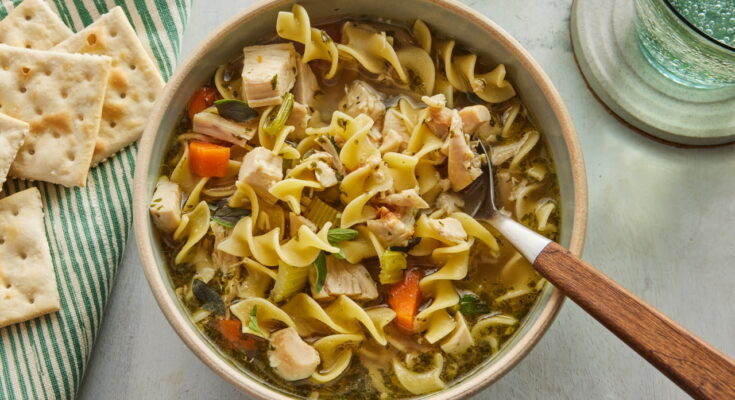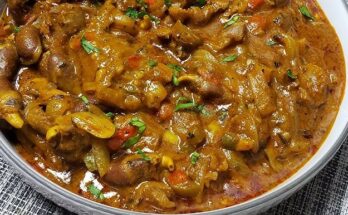Homemade Chicken Noodle Soup Recipe: There’s something timeless and deeply comforting about a steaming bowl of homemade chicken noodle soup. Whether you’re trying to soothe a cold, warm up on a chilly day, or just craving some soul food, this recipe will walk you through every step. From choosing the best ingredients to simmering it to perfection, this is the only guide you’ll need to make a pot of golden, savory, heartwarming chicken noodle soup right at home.
Introduction to the Classic Comfort Food
Chicken noodle soup isn’t just a meal—it’s a feeling. It’s what grandma used to make when you were under the weather or what welcomed you home on a cold, rainy day. This dish has long been known not only for its nostalgic comfort but also for its potential healing qualities. With its clear, herb-infused broth, tender pieces of chicken, soft noodles, and the familiar bite of vegetables like carrots and celery, it’s essentially a hug in a bowl.
Beyond nostalgia, chicken noodle soup is practical. It’s affordable, easy to make in large batches, and flexible enough to suit various dietary needs. Plus, the ingredients are usually kitchen staples—making it a go-to when the fridge is looking a little empty. Whether you’re a beginner in the kitchen or a seasoned home cook, there’s always room to master this staple dish.
Ingredients You’ll Need
The heart of a great chicken noodle soup is in the ingredients. You don’t need anything fancy—just a few fresh, wholesome items that come together beautifully. Here’s what you’ll need:
Basic Ingredients:
- 1 lb boneless, skinless chicken breasts or thighs
- 8 cups chicken broth (preferably low-sodium)
- 3 large carrots, sliced
- 3 celery stalks, sliced
- 1 medium onion, chopped
- 3 cloves garlic, minced
- 1 ½ cups egg noodles
- 2 tbsp olive oil or butter
- Salt and pepper to taste
- 1 tsp dried thyme
- 1 tsp dried parsley (or fresh)
- 1 bay leaf
Optional Add-Ons:
- A squeeze of lemon juice for brightness
- Fresh dill or basil for garnish
- Spinach or kale for extra greens
- Dash of chili flakes for heat
Choosing quality ingredients can significantly boost your soup’s flavor. If you can, go for organic vegetables and good-quality chicken. Fresh herbs like thyme and parsley can add depth that dried versions may not fully achieve.
Tools and Equipment
Making chicken noodle soup doesn’t require a fancy kitchen setup, but the right tools will make the process smoother and more enjoyable. Here’s what you’ll need:
- A large soup pot or Dutch oven: This is where all the magic happens.
- Sharp chef’s knife: For prepping your veggies and chicken.
- Cutting board: Preferably one for meat and one for veggies.
- Wooden spoon or spatula: For sautéing your base.
- Ladle: For serving without mess.
- Strainer (optional): If you prefer a clearer broth, especially after boiling.
These tools are basic yet essential. A sturdy soup pot ensures even cooking, while a good knife will speed up prep time and reduce frustration. Having these ready before you start cooking ensures a smooth, stress-free experience.
Step-by-Step Guide to Making Chicken Noodle Soup
Now we dive into the heart of it—how to actually bring this dish to life. You’ll go from raw ingredients to a bowl of delicious, steaming soup in just a few steps.
Step 1: Prepare Your Ingredients
Before anything hits the pot, it’s all about the prep. This step sets the foundation for everything that follows. Start by washing all your vegetables thoroughly. Then:
- Dice the onions into small pieces for quick cooking and even flavor distribution.
- Slice the carrots and celery into uniform rounds to ensure they cook evenly.
- Mince the garlic finely so it releases its oils and aroma when sautéed.
- Cut the chicken into bite-sized chunks if you’re cooking it in the soup, or leave it whole if you prefer to shred it later.
Preparation might not seem like the most exciting step, but it’s arguably the most important. Rushing through prep can lead to unevenly cooked vegetables or bland bites of chicken. Take your time, enjoy the process, and remember—every slice and chop brings you one step closer to that perfect bowl.
Step 2: Sauté for Maximum Flavor
Now that everything is prepped, it’s time to build the flavor base of your soup. This step transforms a plain broth into something rich and aromatic. Heat your large soup pot over medium heat and add the olive oil or butter. Once it’s shimmering (or melted, if you’re using butter), add the chopped onions.
Let them cook for 3–4 minutes, stirring occasionally, until they become soft and translucent. Then, toss in the garlic. The moment that garlic hits the pot, your kitchen will start to smell amazing. Cook it for about a minute—don’t let it brown, or it can turn bitter.
Next, add in your carrots and celery. Sauté these for another 5–7 minutes. You’re not trying to fully cook them here—just give them a head start and let them soak up that savory garlic and onion base. Sprinkle in the thyme and a bit of salt and pepper at this stage. These dry herbs bloom in the hot oil, releasing their essential oils and taking your soup’s flavor to the next level.
Sautéing might seem like a small step, but it’s what separates a good soup from a great one. Instead of everything tasting like broth, each spoonful will have layers of savory, herbal goodness.
Step 3: Simmer the Soup
Here’s where the magic begins. Once your vegetables are softened and fragrant, it’s time to add the chicken and broth. If you’re using raw chicken, you can either add it whole to shred later or add it diced for faster cooking. Pour in the chicken broth and drop in a bay leaf.
Raise the heat to bring the mixture to a gentle boil, then reduce to a simmer. Cover the pot and let it cook for about 25–30 minutes. If you left the chicken whole, check that it’s cooked through, then remove it to shred with two forks before adding it back to the pot.
During this simmering stage, the flavors really start to develop. The chicken infuses the broth, the herbs work their magic, and the vegetables soften into sweet, earthy bites. Be patient—good soup takes a little time, but it’s always worth the wait.
Want an even richer broth? Simmer for a bit longer. Just make sure your veggies don’t turn to mush. Stir occasionally and skim any foam or fat that rises to the top with a spoon.
Step 4: Add the Noodles
This is where timing becomes crucial. If you add the noodles too early, they’ll overcook and fall apart. Too late, and they’ll be undercooked when you’re ready to serve. The sweet spot? Add the noodles about 8–10 minutes before you plan to eat.
Turn up the heat slightly to a light boil and stir in your egg noodles. These are the classic choice—they’re hearty, tender, and soak up just the right amount of broth without getting soggy. Stir them occasionally to keep them from sticking together or to the bottom of the pot.
Keep the pot uncovered while the noodles cook. This helps them maintain a firmer texture and lets you keep a close eye on them. If you’re planning to store some of the soup for later, consider cooking the noodles separately and adding them to individual servings. That way, they won’t get too soft in the fridge.
You can also experiment with other types of pasta—rotini, shells, or even orzo—but adjust the cooking time accordingly.
Step 5: Season and Serve
The soup’s nearly done—but don’t skip this final step. Before you serve, do a taste test. Adjust the seasoning with more salt, pepper, or a dash of lemon juice if it needs brightness. You can also add more herbs, especially fresh parsley or thyme, for a last-minute flavor boost.
Ladle the soup into bowls and garnish with chopped parsley or a sprinkle of Parmesan cheese if you like. Serve with warm, crusty bread or saltine crackers for the ultimate cozy meal.
This is the moment you’ve been waiting for—watch the steam rise, breathe in that savory aroma, and enjoy the fruits of your labor. This homemade chicken noodle soup isn’t just a meal. It’s a reminder of how simple ingredients, treated with care, can become something truly extraordinary.
Tips for the Best Chicken Noodle Soup
Even a simple dish like chicken noodle soup has room for improvement with a few pro tips. These little adjustments can elevate your soup from average to exceptional:
- Use homemade or high-quality broth: The broth is the soul of the soup. A rich, flavorful stock will carry all the other ingredients beautifully. If you have time, simmer your own broth using chicken bones, onion, garlic, and herbs.
- Sear the chicken beforehand: Browning the chicken before simmering adds an extra layer of depth. It creates those delicious browned bits (called fond) at the bottom of the pot that add umami to your broth.
- Layer your flavors: Don’t just toss everything in at once. Sauté your aromatics, then add herbs, then liquids. Let each element develop before adding the next.
- Don’t overcook the noodles: They continue to cook even after you turn off the heat. For firmer noodles, slightly undercook them and let them finish softening in the hot soup.
- Add acid at the end: A splash of lemon juice or a dash of vinegar brightens up the soup and brings balance to the richness.
Common mistakes include overcooking the chicken (which makes it dry and stringy), adding too much salt too early (which can concentrate during simmering), and overcrowding the pot with too many ingredients. Stick with the essentials, taste as you go, and your soup will be perfect every time.
Variations You Can Try
While the classic version is always a hit, there are plenty of fun ways to change things up depending on your mood or dietary needs:
1. Creamy Chicken Noodle Soup
Add a splash of cream or a dollop of sour cream for a richer texture. You can also stir in a flour-and-butter roux for a thicker consistency.
2. Spicy Chicken Noodle Soup
Add a chopped jalapeño or a teaspoon of red pepper flakes to the sauté step for a little kick. You can also swirl in sriracha or hot sauce before serving.
3. Low-Carb or Keto Version
Swap the noodles for spiralized zucchini, shirataki noodles, or cauliflower rice. Still hearty and comforting, but lighter on carbs.
4. Veggie-Heavy Soup
Add spinach, kale, green beans, or peas for extra color and nutrients. You can even throw in some diced tomatoes or corn for a slightly sweeter profile.
5. Asian-Inspired Chicken Noodle Soup
Use ginger, soy sauce, and a drizzle of sesame oil. Swap egg noodles for rice noodles and top with scallions and a soft-boiled egg.
Each of these twists adds something unique to the soup without straying too far from the comfort you’re craving. Don’t be afraid to get creative—your kitchen, your rules!
Storage and Reheating Tips
One of the best things about chicken noodle soup is that it keeps well and tastes even better the next day. Here’s how to store it right:
- Refrigerator: Store in an airtight container for up to 4 days. Let the soup cool completely before sealing to prevent moisture buildup.
- Freezer: Chicken noodle soup can be frozen for up to 3 months, but it’s best to freeze it without the noodles. Add freshly cooked noodles when reheating to avoid sogginess.
- Reheating: Warm on the stove over medium heat until steaming. If the broth has thickened or reduced, add a bit of water or chicken stock to loosen it.
Batch cooking this soup and freezing half is a great way to ensure you’ve got a delicious, nourishing meal ready to go for busy days or cold evenings. Just label and date your containers so nothing gets forgotten in the freezer.
Nutritional Benefits
Chicken noodle soup isn’t just delicious—it’s incredibly good for you. Here’s why this dish earns its title as a feel-better food:
- High in protein: Thanks to the chicken, it helps build and repair tissues, perfect for recovery or post-workout meals.
- Hydrating: The broth keeps you hydrated, especially when you’re sick or during colder months when you drink less water.
- Rich in vitamins: Carrots provide beta-carotene, celery gives you Vitamin K, and onions offer immune-boosting antioxidants.
- Comfort food for the mind: The warmth, nostalgia, and ease of eating make it great for mental well-being.
And unlike heavy takeout meals or canned soups, this homemade version is lower in sodium and doesn’t include preservatives. If you’re health-conscious, you can easily adjust the ingredients to meet dietary goals without sacrificing flavor.
FAQs about Homemade Chicken Noodle Soup Recipe
1. Can I use pre-cooked chicken in homemade chicken noodle soup?
Yes, using pre-cooked chicken is a great time-saver. Just add it during the final few minutes of cooking to warm it through without overcooking.
2. What type of noodles works best for chicken noodle soup?
Egg noodles are the traditional choice for their texture and ability to hold up well in broth. However, any pasta like rotini, fusilli, or even spaghetti (broken into pieces) can be used.
3. How can I make the soup more flavorful?
Use homemade or low-sodium chicken broth, add fresh herbs like thyme and parsley, and sauté onions, garlic, carrots, and celery before simmering. A splash of lemon juice can also brighten the flavor.
4. Can I freeze homemade chicken noodle soup?
Yes, but it’s best to freeze the soup without noodles. Cooked noodles can become mushy when reheated. Add fresh noodles when you’re ready to serve.
5. How long does homemade chicken noodle soup last in the fridge?
It stays fresh for about 3 to 4 days when stored in an airtight container in the refrigerator.
6. Is this soup good for colds or flu?
Absolutely. The warm broth, vegetables, and lean protein make it soothing and hydrating—perfect comfort food when you’re feeling under the weather.
7. Can I make this soup in a slow cooker?
Yes! Add all ingredients except the noodles and cook on low for 6–8 hours or high for 3–4 hours. Add the noodles during the last 15–20 minutes of cooking.
8. How do I thicken chicken noodle soup?
For a thicker consistency, you can mash a few of the cooked vegetables or add a slurry of cornstarch and water. Some also add a bit of cream for richness.
9. What vegetables can I add to customize the soup?
Beyond the classic trio of carrots, celery, and onions, consider adding spinach, peas, corn, or green beans for extra nutrition and variety.
10. Can I make this soup gluten-free?
Yes, simply use gluten-free noodles and ensure your broth is certified gluten-free.
Conclusion
Homemade chicken noodle soup is a classic for a reason. It’s simple, nourishing, and endlessly comforting. With just a few basic ingredients and a bit of time, you can create something that warms the soul and fills the belly. Whether you stick to the traditional recipe or give it your own personal twist, this is one dish that always delivers.
Cooking it yourself means you get to control every element—from the salt level to the type of noodles. And trust me, once you taste how good it is straight from your own kitchen, you’ll never reach for the canned stuff again.
So next time the weather turns cold, or you just need a little comfort in your day, pull out this recipe. You’ll be glad you did.



